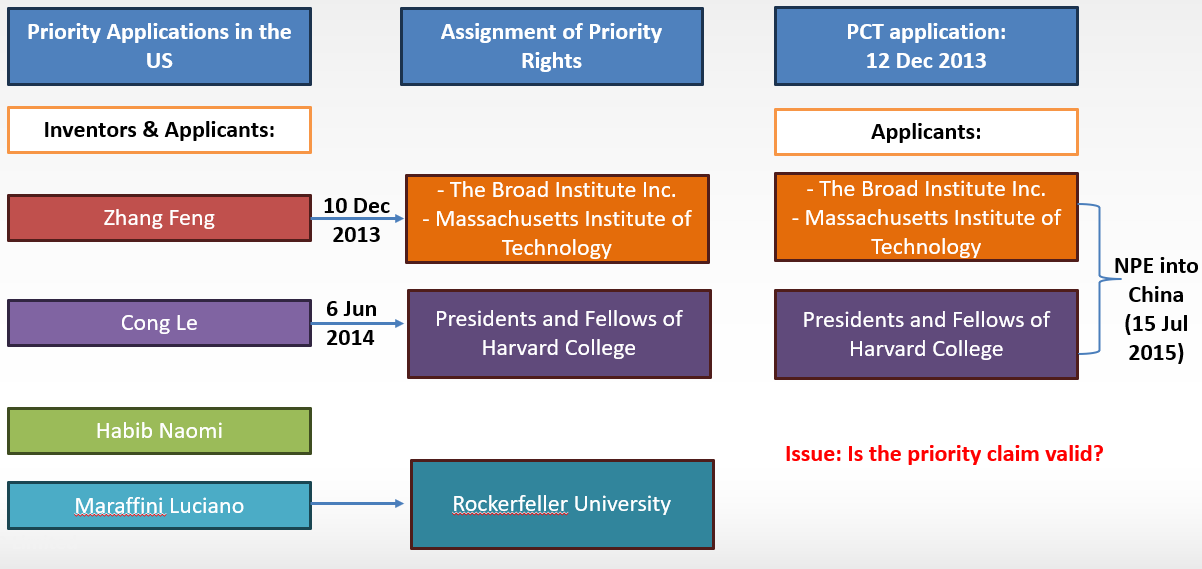The high-profile disputes surrounding an important CRISPR patent belonging to The Broad Institute, MIT and Harvard (hereinafter “the proprietors”) has attracted a lot of attention in recent years, particularly regarding the validity of priority rights that were challenged worldwide. In Europe, the patent was famously revoked by the European Patent Office (hereinafter “EPO”) due to an invalid priority claim1, though recent decisions by EPO suggest a dramatic shift in EPO’s approach that may lead to a different outcome2. Today, we will discuss the decision of the Chinese National Intellectual Property Administration (hereinafter “CNIPA”) in determining whether the proprietors’ priority claims in their CRISPR patent in China were valid, given discrepancies between the applicants in the priority application and the subsequent PCT and Chinese applications. This case brings to light the nuances of claiming priority rights in China and how China’s approach is different from some other countries (Europe and Korea) when it comes to entitlement to priority rights.
Background – claiming priority in China
Priority rights allow an applicant of a patent application to claim the earlier filing date of a previous application (i.e. “priority application”), preventing publications made after the earlier filing date from being used as prior art against the patent application. In China, the CNIPA’s Examination Guidelines (hereinafter “Guidelines”) provide different provisions for the entitlement to claim priority rights under different situations:
- National application claiming domestic priority
For a national application claiming domestic priority, Section 6.2.2.4 in Part I Chapter 1 of the Guidelines states:
“The applicant of the subsequent application claiming priority shall be the same as that of the previous application. If they are different, the applicant of the subsequent application shall submit a document certifying the assignment of the right of priority signed or sealed by all the applicants of the previous application within 16 months from the earliest priority date.” - National application claiming foreign priority
For a national application claiming domestic priority, Section 6.2.1.4 in Part I Chapter 1 of the Guidelines states:
“The applicants of the subsequent application claiming the right of priority shall be the same as the applicant of the previous application, or at least one of the applicants recorded in the certified copy of the previous application document. Where the applicants of the two applications are entirely different, and the right of priority of the previous application has been assigned to the applicant of the subsequent application, a document certifying the assignment of the right of priority, signed or sealed by all of the applicants of the previous application, shall be submitted within 16 months from the earliest priority date.” - National phase entry (NPE) of International Application (PCT) claiming domestic priority
For NPE of an international application (PCT) claiming foreign priority, the requirements are identical to those of a national application claiming domestic priority, as per Section 5.2.6 in Part III Chapter 1 of the Guidelines. - National phase entry (NPE) of International Application (PCT) claiming foreign priority
For NPE of an international application (PCT) claiming foreign priority, Section 5.2.3.2 in Part III Chapter 1 of the Guidelines states:
“Where the earlier application is not filed with the Patent Office, the applicant shall be considered to have right to claim the right of priority if one of the following requirements has been met:
(1) the applicant of the later application is the same as that of the earlier application;
(2) the applicant of the later application is one of the applicants of the earlier application;
(3) the applicant of the later application enjoys the right of priority as the result of assignment or gift of the applicant of the earlier application or transfer of right in other form.”
For cases under (3), Section 5.2.3.2 further states that “except that the applicant has made a declaration of enjoying the right of priority in the international phase and the declaration meets the requirements, the applicant shall submit the relevant certifying documents. The certifying documents shall be signed or sealed by the assignor(s). The certifying documents shall be the original documents or the certified copy of the original documents.”
It can be observed that the requirements for claiming priority rights are stricter for applications claiming domestic priority compared to those claiming foreign priority, with the national phase entry (NPE) of PCT application claiming foreign priority being the most lenient. The differences in requirements for claiming priority rights under different situations are summarized in the table below:
|
|
| |
Applicant |
|
|
|
Formality requirement for the transfer document |
|
|
|
Relevant sections | Part I Chapter 1 Section 6.2.2.4 (National application) Part III Chapter 1 Section 5.2.6 (NPE) | Part I Chapter 1 Section 6.2.1.4 | Part III Chapter 1 Section 5.2.3.2 |
Case Facts
The Chinese patent under dispute for this invalidation case is CN201380070567.X, which was filed and granted under the names of The Broad Institute Inc. (hereinafter “Broad”), Massachusetts Institute of Technology (hereinafter “MIT”) and Presidents and Fellows of Harvard College (hereinafter “Harvard”). The Chinese patent was derived from the PCT application no. PCT/US2013/074819, which claims priority from a few US provisional applications. The dispute arose because the proprietors had filed the PCT application (and the subsequent NPE into China) without naming some of the priority applicants (Marraffini Luciano and Habib Naomi) or Marraffini’s successor in title (the Rockefeller University) as the applicants in the PCT application.
This case revolves around a key question: do inconsistencies in applicants between the priority application and the subsequent applications undermine the proprietors’ right to claim priority in China?

PRD’s Decision and Reasoning
The petitioner argued that Part III of the Guidelines, which governs the examination rules for NPE of PCT applications into China, is unclear regarding which provision to apply where the applicants in the previous application and the subsequent application are entirely different, as in this case. It was argued that since priority rights are derived from application rights, priority rights should not be transferred without the consent of all joint applicants.
In its decision, the Patent Re-examination and Invalidation Department (hereinafter “PRD”) of the CNIPA held that:
- Entitlement of Priority Rights
By referring to Part III Chapter 1 Section 5.2.3.2 as discussed above, PRD states that for an international application entering the national phase in China which claims foreign priority, there are 3 scenarios where the applicant(s) shall be considered to have the right to claim priority:
(1) the applicant of the later application is the same as that of the earlier application;
(2) the applicant of the later application is one of the applicants of the earlier application;
(3) the applicant of the later application enjoys the right of priority as the result of assignment or gift of the applicant of the earlier application or transfer of right in other form.”
The PRD further explained that when the applicant(s) of the later application satisfies the criteria listed in (1) or (2) as the successor(s) in title due to the transfer of rights in (3), they should be able to enjoy the priority rights. Unlike the stricter requirements in applications claiming domestic priority, for NPE of a PCT application which claim foreign priority, it is not required that the applicants (or their successors in title) of the prior application and the subsequent application are completely identical.
For the present case, as long as the priority rights are properly transferred (under the criterion (3)) from one or more of the applicants of the earlier application (Zhang Feng and Cong Le in this case) to the proprietors (Broad, MIT and Harvard), this will satisfy criterion (2) and the proprietors will be entitled to the right to claim priority.
This is different from the much stricter approach taken in Europe and South Korea, which requires the applicant of the prior application and the subsequent application to be completely identical in order to enjoy priority rights. If they are not the same, the submission of relevant proof of assignment from all applicants is necessary. - Validity of the Transfer Document
The petitioners argued that all applicants in the priority application must sign the transfer document to validate the priority claim. The PRD, however, focused on the meaning of “assignor” mentioned in Section 5.2.3.2 (i.e. “the certifying documents shall be signed or sealed by the assignor(s)”), interpreting it more leniently to mean “any assignor” listed as an applicant in the priority application, rather than all co-applicants. In other words, a proof of assignment from all applicants is not necessary.
Therefore, in the present case, the transfer document signed by Zhang Feng assigning the rights to Broad and MIT, and the transfer document signed by Cong Le assigning the rights to Harvard, validly transfer the priority rights to the proprietors, satisfying criterion (3) in Section 5.2.3.2. - On the Nature of Priority Rights
The PRD justified its decision by drawing a distinction between priority rights and right of application. It emphasized that while priority rights are significant, they don’t hold the same legal weight as the full right of application. Priority rights are essentially time-based and tied to the novelty determination process. Thus, the PRD reasoned that allowing flexibility in transfer of priority rights, where only one assignor’s consent is needed, does not severely impact the other co-applicants’ rights.
In conclusion, the PRD upheld the proprietors’ priority claim.
Concluding Thoughts: Transferring Priority Rights in China
We believe this case was chosen as a “Top 10 Patent Re-examination and Invalidation case” to illustrate China’s more flexible approach to priority rights (at least for PCT applications entering via national phase), providing foreign applicants more leeway compared to the stricter European and Korean requirements. This flexibility might encourage international applicants to seek patent protection in China, given its comparatively accommodating stance on priority transfers. It will also be interesting to follow the future developments in other jurisdictions on this matter, especially in Europe, which appears to be moving away from its stricter approach to ‘same applicant’ priority.
This article is for general informational purposes only and should not be considered legal advice or a legal opinion on a specific set of facts.
About the Author

Eddie Ho is qualified Chinese Patent Attorney at Eagle IP, a Boutique Patent Firm with offices in Hong Kong and Shenzhen.





